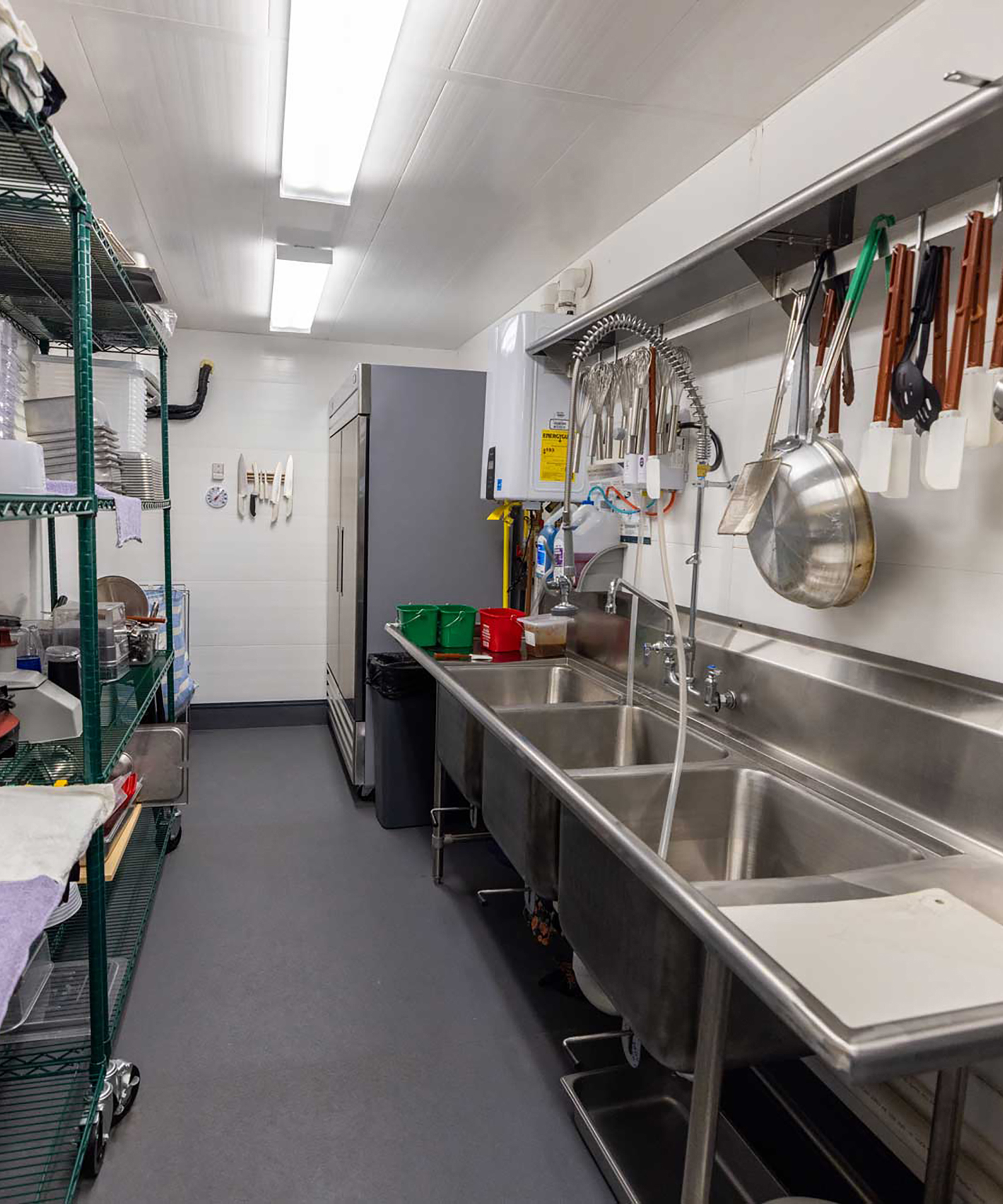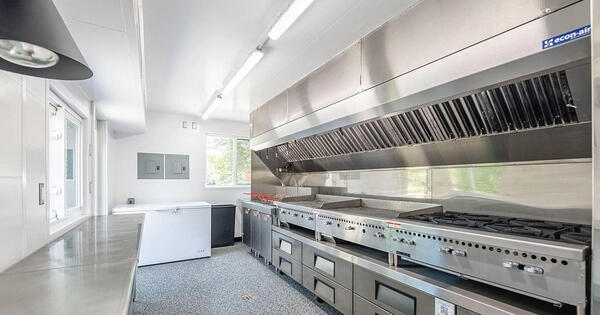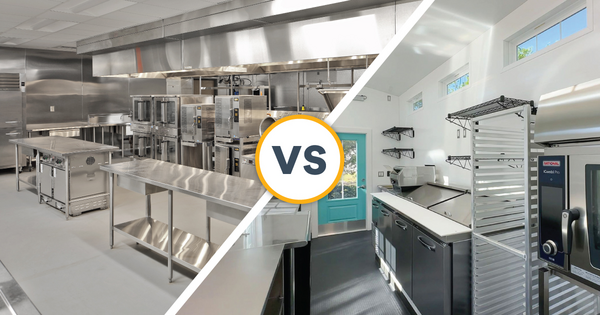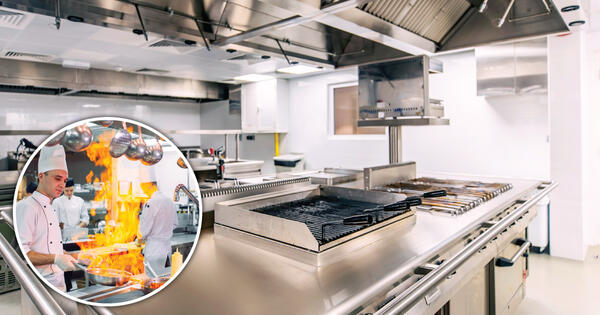This post was originally published in March 2023. Last updated: May 2025.
Commercial kitchens are fast-paced, high-heat, and high-moisture environments where sanitation and safety aren't just nice to have. They're legally required. From constant steam and grease to accidental splashes and food particles, nearly every surface gets put to the test daily. And that includes the walls. While it’s easy to focus on equipment and flooring, wall surfaces are a foundational part of creating a safe and compliant kitchen.

What Are FRP Wall Panels?
Fiberglass Reinforced Plastic — commonly known as FRP — is a composite wall panel system designed to handle demanding environments. These panels are made by embedding fiberglass strands into a plastic resin matrix, then curing the material to create a rigid sheet. A protective gel coat is often applied to the surface for added resistance.
On paper, FRP panels seem like a strong candidate: They’re moisture-resistant, relatively lightweight, and feature a smooth surface that's easy to wipe down. However, the reality on the job site and over the life of the product tells a different story.
Key Benefits of FRP Wall Panels and Why They’re Falling Behind
In a busy commercial kitchen, materials must stand up to constant use, fast-paced cleaning, and unforgiving inspection standards. FRP panels are designed to meet those needs, but their performance often comes with caveats.
Let’s take a look at their typical benefits — and where they fall short compared to modern PVC panels like Trusscore:
- Moisture resistance: While FRP won’t swell or peel when exposed to humidity, its seams can be weak points. Improperly sealed joints can trap moisture and lead to bacteria and mold growth — a major hygiene red flag.
- Durability in high-traffic settings: FRP is impact-resistant, but it’s not immune to damage. Cracks and gouges from carts and equipment are common, and repairs are usually difficult and visible.
- Cleaning efficiency: The panel surface is smooth, but cleaning around moldings and seam covers can be time-consuming — especially when silicone sealants degrade or peel.
- Lower maintenance than tile: FRP is easier to maintain than tile grout, but it's still more complicated than seamless PVC panels.
- Regulatory compliance: FRP meets USDA and FDA requirements — but so do several newer alternatives that eliminate the drawbacks of fiberglass and glue-on trim altogether.
FRP may check a lot of boxes on paper, but in practice, it often introduces avoidable challenges — especially when compared to streamlined systems like Trusscore.
Common Challenges and Limitations of FRP Panels
One of the biggest issues is installation complexity. FRP needs a clean, dry, and flat substrate, solvent-free adhesive application, specialty cutting tools, corrosion-resistant fasteners, and precise seam finishing—adding up to a time-consuming process that’s less efficient than modern interlocking systems that skip the glue and trim altogether. Skipping any prep step — or failing to get every seam just right — can lead to bubbling, delamination, or worse: bacteria-trapping gaps. Other drawbacks include:
- Seam and joint vulnerability: Seams must be meticulously sealed with food-safe silicone or plastic moldings. If not maintained, these areas trap grease and moisture, creating hidden sanitation risks.
- Regulatory compliance: FRP panels are widely accepted because they meet health code standards but so do many newer materials that address the weak points FRP leaves behind. FRP’s compliance typically depends on how well it’s installed. Without proper sealing and substrate prep, even the best-rated panels can fail hygiene checks.
- Impact damage: FRP can crack or chip under repeated blows and repairing it to a hygienic, seamless state is difficult and time-consuming.
- Aesthetic wear and yellowing: Panels often show discoloration around edges or from UV exposure, which can give kitchens a worn-out look over time.
- Limited repair options: Once damaged, FRP panels are difficult to patch discreetly. Full panel replacement is often required — adding labor and cost.
These issues are precisely why many contractors are making the switch to easier-to-install, longer-lasting alternatives like Trusscore Wall&CeilingBoard.
FRP vs. Other Commercial Kitchen Wall Materials
Choosing the right wall material for a commercial kitchen isn't just about initial cost — it’s about long-term performance, ease of maintenance, and how well the material holds up under the pressure of constant cleaning and code inspections. FRP has long been a go-to solution, but it’s not the only option on the table. '
Here’s how it stacks up against other common choices:
- Ceramic tile: Tile offers a hard, durable surface that’s resistant to heat and moisture — but it’s labor-intensive to install and can be costly upfront. Grout lines are a major hygiene concern in kitchens, often requiring constant scrubbing and regular resealing to prevent mold or bacteria buildup.
- Stainless steel: Known for its exceptional durability and cleanability, stainless steel is often used behind cooklines or in high-heat zones. But it comes at a high price point and is more difficult to install, especially on large surfaces. It’s also prone to scratching and denting over time.
- PVC wall panels: Newer PVC-based systems — like Trusscore — offer a compelling alternative to FRP. Trusscore Wall&CeilingBoard panels are lighter, more rigid, and easier to install. The panels also feature interlocking designs that eliminate the need for glue or mechanical fasteners, and they don’t have the same issues with seam exposure or fiberglass shedding. While FRP still performs well, PVC wall panels are quickly gaining ground for professionals who want a cleaner, more modern solution with fewer installation headaches.



Trusscore Wall&CeilingBoard is a High-Performance Alternative to FRP
For pros who are tired of the installation hassles and seam maintenance that come with traditional FRP, Trusscore Wall&CeilingBoard offers a smarter, faster, and cleaner solution. Designed for demanding environments like commercial kitchens, it delivers all the durability and hygiene benefits you need without any of the trade-offs.
Here’s why contractors and kitchen designers are making the switch:
- Superior Cleanability: Kitchens demand spotless surfaces — and Trusscore delivers. The panels are smooth, non-porous, and can be repeatedly cleaned and disinfected without showing wear. They’re pressure washable and resistant to chemicals and staining. Better yet, Trusscore Wall&CeilingBoard is antimicrobial, offering added protection against bacteria, mold, and viruses (tested to ISO 846:2019 standards) — something FRP simply can’t match.
- Faster, Easier Installation: FRP panels require a multi-step installation process with glue, backers, and multiple installers. Trusscore panels are pre-finished and install directly to studs or over drywall with a simple screw flange and tongue-and-groove system that hides fasteners and speeds up work. That means faster kitchen turnovers and less downtime.
- Built to Withstand High-Traffic, High-Impact Environments: Commercial kitchens are busy, high-impact environments. While FRP was designed for heavy-duty industries like aerospace and marine, it doesn’t always hold up well in high-traffic interior settings. Trusscore’s PVC composition and inner truss design provide outstanding strength and rigidity, allowing the panels to resist dents, cracks, and abrasion better than FRP.
- Meets Health Code Requirements: Trusscore Wall&CeilingBoard complies with all major regulatory standards, including FDA, USDA, and CFIA guidelines for use in food preparation areas when installed with approved caulking. Whether you're building a prep room, dishwashing area, or full production kitchen, you can be confident your walls and ceilings will pass inspection.
- More Hygienic Over Time: Over time, FRP panels can delaminate — especially in wet areas — creating gaps where mold and mildew thrive. Because Trusscore is made from solid PVC and doesn’t use a backer, it's 100% water- and moisture-resistant and will never peel, rot, or absorb water.
- Safer and Healthier for Occupants: Trusscore Wall&CeilingBoard is low-VOC compliant, including low formaldehyde levels. Unlike FRP, which requires glue that can emit harmful VOCs, Trusscore contributes to a safer indoor air environment — a major plus for enclosed kitchen spaces.
- Long-Term Value: FRP is difficult to recycle and may need replacing every five years in demanding environments like commercial kitchens. In contrast, Trusscore is 100% recyclable, with a service life of up to 100 years, and can be recycled up to seven times.
Trusscore Wall&CeilingBoard brings modern innovation to commercial kitchen design — reducing downtime, improving hygiene, and helping you deliver projects that stand up to real-world conditions. When speed, safety, and simplicity matter, it’s a solution worth considering.
Budget & Lifecycle Considerations
When evaluating wall panel options for a commercial kitchen, it’s not just about the price per sheet — it’s about the full lifecycle cost, from installation to long-term upkeep. While FRP panels might seem like a budget-friendly choice at first glance, it’s important to factor in labor, maintenance, and durability over time. Let’s break it down:
- Initial material costs: FRP panels are typically less expensive than stainless steel or high-end tile, making them an attractive option for cost-conscious projects. However, newer PVC-based systems like Trusscore are competitively priced, especially when you account for their built-in features that reduce the need for additional materials like backers, adhesives, or surface trim.
- Installation expenses: Installing FRP can be labor-intensive. The panels must be glued to a clean, flat substrate, and seams require caulking and capping to maintain hygiene standards — all of which adds time and complexity. Trusscore, by contrast, installs directly to studs or over existing surfaces using a tongue-and-groove system, cutting install time significantly and reducing labor costs.
- Ongoing maintenance and repair: FRP panels can wear down at seams and joints over time, especially in high-moisture environments. Caulking can shrink or peel, requiring reapplication. If a panel gets damaged, replacement can be tricky. Trusscore’s PVC construction resists mold and mildew, and its tight-fitting joints don’t rely on adhesives or sealants. The result — lower maintenance, longer lifespan, and less risk of downtime for cleaning or repair.
All in, FRP may appear cheaper at the outset, but PVC-based systems like Trusscore often deliver better value in the long run thanks to faster installs and reduced maintenance needs.
In the end, the right wall panel comes down to your priorities: If low upfront cost is the driver, FRP may do the job. But if you’rethinking about total cost of ownership, labor savings, and long-term durability, it’s worth considering a smarter, more streamlined system like Trusscore.






